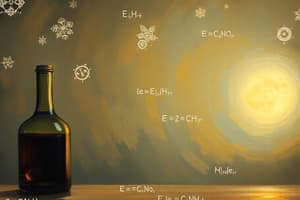Podcast
Questions and Answers
What is the main purpose of a chemical equation?
What is the main purpose of a chemical equation?
- To illustrate the energy changes during a reaction
- To describe the colors of reactants and products
- To identify the physical states of substances involved in the reaction
- To represent the reactants and products of a chemical reaction (correct)
In photosynthesis, which of the following are the reactants?
In photosynthesis, which of the following are the reactants?
- Carbon dioxide and water (correct)
- Hydrogen and carbon
- Chlorophyll and sunlight
- Glucose and oxygen
Why is balancing chemical equations important?
Why is balancing chemical equations important?
- To ensure the products are more numerous than reactants
- To comply with the law of conservation of matter (correct)
- To reflect the physical appearance of substances
- To demonstrate energy transformation
What do the coefficients in a balanced chemical equation indicate?
What do the coefficients in a balanced chemical equation indicate?
Which law states that matter cannot be created or destroyed in a chemical reaction?
Which law states that matter cannot be created or destroyed in a chemical reaction?
What constitutes the products in a chemical reaction?
What constitutes the products in a chemical reaction?
During photosynthesis, which molecule is produced along with glucose?
During photosynthesis, which molecule is produced along with glucose?
What type of bonds are involved in forming new substances during a chemical reaction?
What type of bonds are involved in forming new substances during a chemical reaction?
In a chemical reaction, substances are transformed, leading to the creation of new substances.
In a chemical reaction, substances are transformed, leading to the creation of new substances.
Photosynthesis converts glucose and oxygen into carbon dioxide and water.
Photosynthesis converts glucose and oxygen into carbon dioxide and water.
The Law of Conservation of Matter states that matter can be created or destroyed during a chemical reaction.
The Law of Conservation of Matter states that matter can be created or destroyed during a chemical reaction.
Balancing chemical equations ensures that the same number of atoms of each element are present on both sides of the equation.
Balancing chemical equations ensures that the same number of atoms of each element are present on both sides of the equation.
In the balanced photosynthesis equation, one molecule of glucose is produced from six molecules of carbon dioxide and six molecules of water.
In the balanced photosynthesis equation, one molecule of glucose is produced from six molecules of carbon dioxide and six molecules of water.
Reactants in a chemical reaction are the newly formed substances from the interaction.
Reactants in a chemical reaction are the newly formed substances from the interaction.
Coefficients in a balanced chemical equation represent the number of atoms of each element involved.
Coefficients in a balanced chemical equation represent the number of atoms of each element involved.
Chemical bonds in reactants are broken and reformed during a chemical reaction.
Chemical bonds in reactants are broken and reformed during a chemical reaction.
Flashcards
Chemical Reaction
Chemical Reaction
A process where substances interact to form different substances by breaking, forming, or rearranging chemical bonds.
Reactants
Reactants
Substances that react and change during a chemical reaction.
Products
Products
New substances created as a result of a chemical reaction.
Chemical Equation
Chemical Equation
Signup and view all the flashcards
Law of Conservation of Matter
Law of Conservation of Matter
Signup and view all the flashcards
Coefficients
Coefficients
Signup and view all the flashcards
Photosynthesis
Photosynthesis
Signup and view all the flashcards
Glucose (C6H12O6)
Glucose (C6H12O6)
Signup and view all the flashcards
What is a chemical reaction?
What is a chemical reaction?
Signup and view all the flashcards
What are reactants?
What are reactants?
Signup and view all the flashcards
What are products?
What are products?
Signup and view all the flashcards
What is a chemical equation?
What is a chemical equation?
Signup and view all the flashcards
What is the Law of Conservation of Matter?
What is the Law of Conservation of Matter?
Signup and view all the flashcards
What does balancing a chemical equation mean?
What does balancing a chemical equation mean?
Signup and view all the flashcards
What are coefficients in a chemical equation?
What are coefficients in a chemical equation?
Signup and view all the flashcards
What is photosynthesis?
What is photosynthesis?
Signup and view all the flashcards
Study Notes
Chemical Reactions
- A chemical reaction is a process where substances interact to form different substances by breaking, forming, or rearranging chemical bonds.
- Substances participating in a chemical reaction can be ionic or covalent compounds, as well as atoms, ions, or molecules of elements.
- Photosynthesis is an example of a chemical reaction.
- Plants utilize the Sun's energy to combine carbon dioxide from air and water from soil into glucose (a sugar) and oxygen.
- Carbon dioxide and water are the reactants in this reaction, as they change by combining and reacting together.
- Glucose and oxygen are the products because they are the new substances created by the reaction.
- Scientists describe chemical reactions using a chemical equation.
- A chemical equation includes the chemical formulas of the reactants on the left side and the product formulas on the right side.
- Reactants and products are created from the same elements (e.g., carbon, oxygen, and hydrogen in the photosynthesis example).
- The amounts and types of elements in the reactants must be equal to the amounts and types of elements in the products.
- Balancing chemical equations is crucial due to the law of conservation of matter.
- This law states that matter cannot be created or destroyed, only transformed.
- Thus, the number of atoms of each element in the reactants must equal the number of atoms of each element in the products.
- The balanced chemical equation for photosynthesis:
- 6CO2 + 6H2O -> C6H12O6 + 6O2
- This shows that six molecules of carbon dioxide (CO2) react with six molecules of water (H2O) to produce one molecule of glucose (C6H12O6) and six molecules of oxygen (O2).
- The numbers in front of the formulas are called coefficients, indicating the number of molecules of each reactant and product.
- If there is no coefficient, it means one molecule of that substance is present.
Key Takeaways
- Chemical reactions involve the rearrangement of atoms and molecules.
- Reactants are the starting materials, and products are the substances formed.
- Chemical equations represent chemical reactions, balancing the number of atoms of each element on both sides.
- The law of conservation of matter ensures that atoms are neither created nor destroyed in a chemical reaction.
Studying That Suits You
Use AI to generate personalized quizzes and flashcards to suit your learning preferences.




